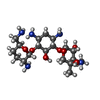+Search query
-Structure paper
| Title | Cryo-EM Structures of AcrD Illuminate a Mechanism for Capturing Aminoglycosides from Its Central Cavity. |
|---|---|
| Journal, issue, pages | mBio, Vol. 14, Issue 1, Page e0338322, Year 2023 |
| Publish date | Feb 28, 2023 |
 Authors Authors | Zhemin Zhang / Christopher E Morgan / Meng Cui / Edward W Yu /  |
| PubMed Abstract | The Escherichia coli acriflavine resistance protein D (AcrD) is an efflux pump that belongs to the resistance-nodulation-cell division (RND) superfamily. Its primary function is to provide resistance ...The Escherichia coli acriflavine resistance protein D (AcrD) is an efflux pump that belongs to the resistance-nodulation-cell division (RND) superfamily. Its primary function is to provide resistance to aminoglycoside-based drugs by actively extruding these noxious compounds out of E. coli cells. AcrD can also mediate resistance to a limited range of other amphiphilic agents, including bile acids, novobiocin, and fusidic acids. As there is no structural information available for any aminoglycoside-specific RND pump, here we describe cryo-electron microscopy (cryo-EM) structures of AcrD in the absence and presence of bound gentamicin. These structures provide new information about the RND superfamily of efflux pumps, specifically, that three negatively charged residues central to the aminoglycoside-binding site are located within the ceiling of the central cavity of the AcrD trimer. Thus, it is likely that AcrD is capable of picking up aminoglycosides via this central cavity. Through the combination of cryo-EM structural determination, mutagenesis analysis, and molecular simulation, we show that charged residues are critically important for this pump to shuttle drugs directly from the central cavity to the funnel of the AcrD trimer for extrusion. Here, we report cryo-EM structures of the AcrD aminoglycoside efflux pump in the absence and presence of bound gentamicin, posing the possibility that this pump is capable of capturing aminoglycosides from the central cavity of the AcrD trimer. The results indicate that AcrD utilizes charged residues to bind and export drugs, mediating resistance to these antibiotics. |
 External links External links |  mBio / mBio /  PubMed:36625574 / PubMed:36625574 /  PubMed Central PubMed Central |
| Methods | EM (single particle) |
| Resolution | 2.95 - 3.09 Å |
| Structure data | EMDB-28848, PDB-8f3e: EMDB-28855, PDB-8f4n: EMDB-28857, PDB-8f4r: EMDB-28861, PDB-8f56: |
| Chemicals |  ChemComp-LLL: |
| Source |
|
 Keywords Keywords | MEMBRANE PROTEIN / aminoglycoside efflux pump / AcrD / E.coli |
 Movie
Movie Controller
Controller Structure viewers
Structure viewers About Yorodumi Papers
About Yorodumi Papers












